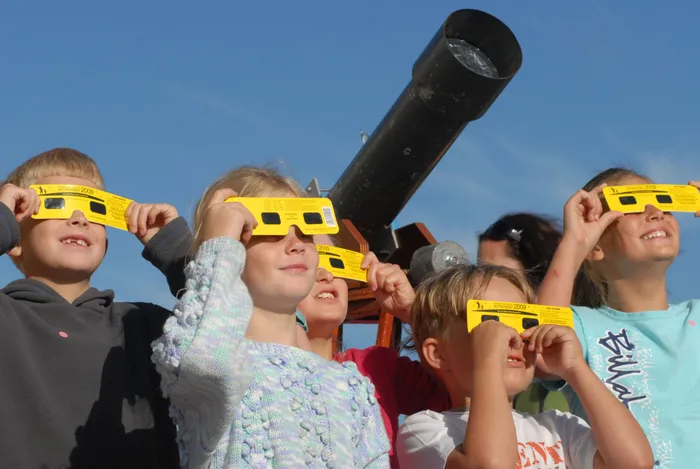From the Archives: Total eclipse of the sun was a delightful phenomenon in 2002

From the Archives: Alex Main (back with grey top), Jessica-Laine Vels (jersey), Rebecca Stead (back), Peter Stead (white T-shirt) and Victoria-Leigh Vels. File picture: Picture: Tracey Adams/African News Agency (ANA) Archives
As part of our festive season content, the “Cape Argus” retrieved articles from its archives looking at what made news in 1922, and 2002.
The article below was published in the “Cape Argus” dated Cape Town, Wednesday, December 4, 2002.
(Note: The author of the original article was .)
It’s a day-night thriller
Skies darkened over southern Africa and Australia as a rare total solar eclipse raced across both continents delighting astronomers, astounding tourists and confusing animals as day became night.
“It’s amazing for us,” said 15-year-old Rhengu Baloyi as he peered skywards with special eclipse glasses distributed by tourism authorities at Musina’s eclipse festival. The eclipse first touched African shores at around 7.15 am.
Starting from Angola, the lunar shadow sped eastward across the continent at speeds greater than 5 000km/h, momentarily casting parts of Namibia, Botswana, Zimbabwe and South Africa into darkness before heading out to sea at Xai-Xai in Mozambique.
The total eclipse touched southern Australia at 11.10 am SA time. In and around the Kruger National Park, thousands of foreign tourists with zoom lenses mingled with locals in full tribal attire to capture the moment.
There were overcast skies this morning, but the Sun made brief showings and watchers caught short glimpses of its progress. In an effort to make sure eclipse viewing would be a safe experience in the park, rangers armed with rifles patrolled viewing sites. A team of NASA scientists were there to record the eclipse.
“There, that’s magic,” said Chery Hochfelden, a Johannesburg housewife, as the light from behind the clouds dimmed and the sky turned a deep twilight.
Onlookers toasted the occasion with vodka cocktails as it grew colder, the sky grew black and the Moon occluded the Sun.
Nearby, dancers kicked up clouds of dust at an all-night rave party held to mark the eclipse.
People sporting nose-rings, tattoos and tie-dyed shirts boogied in the bush booming techno music.
“It was amazing. Life is never going to be the same after this,” said Ben, a wild-haired rave fan from Cape Town decked out in surfer necklaces and mirrored sunglasses.
Wildlife experts said the eclipse could be briefly confusing for animals, but the speed with which daylight returned would probably prevent any serious impact.
The eclipse had been billed as a big tourism draw, with towns along the total path of the eclipse setting up special festivals and travel companies packing tourists into hotels and game lodges.
But some businesses reported less than stellar sales, which they attributed to overpriced tour packages, some cancellations following a series of attacks on tourists and general excessive hype around the event.
“It’s a marvellous opportunity which has become a disaster.”
Cape Argus Environment writer John Yeld travelled up to Sathirunzin, where a campsite was set up, especially for eclipse viewers 60km from Thohoyandou, where cloud cover blocked out most of the eclipse.
“It’s 4 am we were still sitting up watching the shooting stars, but then the clouds started rolling in, and at the time of the eclipse it was even threatening to rain.
“We drove out to a small tribal village Tshipise and watched the eclipse from a square. Fortunately, in the 90 seconds of the full eclipse, it got really dark. There were about 100 people, schoolchildren with special glasses, and once it got light the people started clapping and cheering.
“Then one of the visitors started explaining to the locals exactly what happened, drawing diagrams in the dust.”
In Cape Town, workers and early-morning shoppers gathered on the street corner to watch the eclipse through a variety of protective screens.
Besides the Cape Argus eclipse viewers, people used folded-up pieces of foolscap paper and teabag foil to watch the event.
At the natural history museum at the top end of the Company’s Gardens, tourists and some scientists gathered around a trio of telescopes to record the event, to much chatter, questions and explanations as the moon hid part of the sun and created a soft, early-morning feel to the surrounds.

From the Archives: The legacy of Muay Thai king Quentin 'Dragon' Chong
Potchefstroom man blamed cop’s desire for promotion as defence against theft charge in 1922
How a Cape optician was fined £10 in 1922 for using cocaine to pull six teeth for a woman
From the Archives: A Cape man was found guilty of stealing a £5 cheque a hundred years ago
Related Topics: